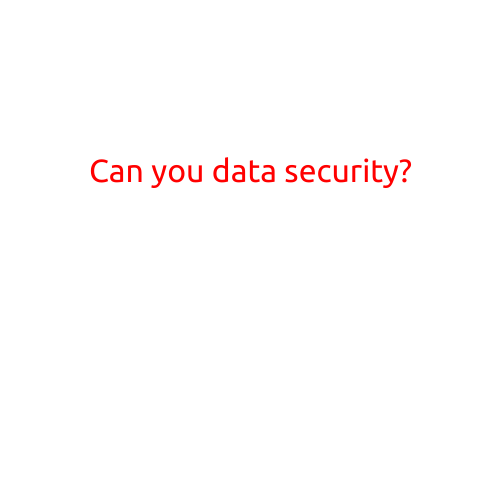
Can You Secure Your Data?
In today’s digital age, data security has become a top priority for individuals and organizations alike. With the rise of cyberattacks, data breaches, and the increasing reliance on technology, the importance of securing sensitive information cannot be overstated. But, can you truly secure your data?
The Risks
Data breaches can be devastating, resulting in financial losses, reputational damage, and even legal consequences. According to a recent report, over 4 billion records were compromised in 2020 alone. The most common types of attacks include:
- Phishing emails: Malicious emails designed to trick victims into revealing login credentials or other sensitive information.
- Ransomware attacks: Malicious software that encrypts data and demands payment in exchange for the decryption key.
- Social engineering: Tricking individuals into revealing sensitive information through psychological manipulation.
- Malware: Software designed to harm or exploit computer systems.
- Network vulnerabilities: Weaknesses in network configurations that allow hackers to gain unauthorized access.
The Consequences
The consequences of a data breach can be severe:
- Financial losses: Replacing stolen data, notifying affected individuals, and investing in cyber insurance can be costly.
- Reputation damage: A data breach can tarnish an organization’s reputation and erode customer trust.
- Legal and regulatory issues: Failure to comply with data protection regulations can result in legal action and penalties.
- Identity theft: Stolen personal data can be used for fraudulent purposes.
The Solutions
While the risks and consequences of a data breach are significant, there are steps you can take to secure your data:
- Use strong passwords: Combine uppercase and lowercase letters, numbers, and special characters to create unique and complex passwords.
- Enable two-factor authentication: Add an extra layer of security by requiring a second form of verification, such as a code sent to your phone or a biometric scan.
- Keep software up to date: Regularly update your operating system, browser, and software to patch vulnerabilities and fix security holes.
- Use encryption: Encrypt sensitive data, such as financial information or personal identifiable information, to make it unreadable to unauthorized parties.
- Monitor your accounts: Regularly check your bank and credit card statements for suspicious activity and report any unauthorized transactions.
- Use a VPN: Virtual private networks (VPNs) encrypt your internet connection when using public Wi-Fi networks.
- Implement backup and disaster recovery: Regularly backup your data and have a plan in place in case of a data breach or system failure.
Conclusion
Securing your data is a critical aspect of protecting your digital identity and preventing unauthorized access to sensitive information. By understanding the risks and taking proactive steps to secure your data, you can minimize the likelihood of a data breach and mitigate the consequences if one does occur. Remember, data security is an ongoing process that requires vigilance and attention to detail.
Additional Tips
- Use antivirus software to scan your computer and mobile devices for malware.
- Be cautious when clicking on links or downloading attachments from unfamiliar sources.
- Use a password manager to generate and store unique passwords for each account.
- Regularly delete unnecessary data and update your software regularly.
- Educate yourself and others on data security best practices.





